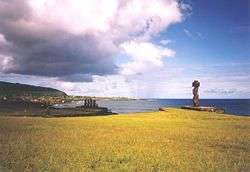Eugène Eyraud

Eugène Eyraud (1820 – 23 August 1868) was a lay friar of the Congregation of the Sacred Hearts of Jesus and Mary and the first Westerner to live on Easter Island.
Early life
Eyraud was born in Saint-Bonnet-en-Champsaur, France, in 1820. He became a mechanic by profession. He went to Bolivia, and acquired mining interests there.
Arrival on Easter Island
Eyraud entered the Holy Ghost Fathers as a novice. Influenced by his brother Jean, a missionary in China, he left Chile for Tahiti in 1862 and arrived at Hanga Roa on 2 January 1864. He was harassed by the islanders, and only stayed nine months before being repatriated to Chile on 11 October 1864. A year and a half later, on 27 March 1866, he settled on the island as a full priest, accompanied by Hippolyte Roussel and three Mangarevan converts.
Activities
Although fiercely opposed at first, Eyraud eventually came to be highly popular and influential among the islanders. In October 1866, Gaspar Zumbohm and Théodule Escolan joined Eyraud and Roussel in their mission, and set up schools at Hanga Roa and Vaihū.
On 22 December 1866 Eyraud wrote
The chances of triumph show themselves day by day to be ever more certain, and the hour of Providence seems to have arrived for the inhabitants of Easter Island. The mission was established the moment the work of destruction touched its final limits: destruction in the material order, destruction in the moral order.[1]
He assisted that year in what would be the last ceremony of the Birdman cult.
Eyraud brought tuberculosis to the island in 1867, which led to the death of a quarter of the island's population, and died of it on 23 August 1868, nine days after the last islanders had been baptized.
Rongorongo
During his first stay, Eyraud remarked that in each house there were wooden tablets covered with "hieroglyphs", now known as rongorongo, but that the islanders no longer knew how to read them and paid them scant attention. He didn't think of informing Roussel or Zumbohm, and never wrote of them again. In wasn't until 1869, when Zumbohm presented a gift which, unknown to him included a tablet, to Bishop Jaussen in Tahiti, that rongorongo was noticed by the outside world.
Traditional beliefs
Eyraud wrote of the islanders and their carved wooden statues, known as mo‘ai kavakava
Although I always lived with them in the greatest familiarity, I have not been able to find any positive act of religious worship. In all the houses, you can see many statuettes about thirty centimeters in height representing men, fish, birds, etc. […] These are undoubtedly idols, but I never found them given any kind of honour. I saw, on the occasion the natives take these statues outside, them making a few gestures and accompanying all this with a kind of meaningless dance and chant.[2]
Bibliography
- L'île de Paques: des dieux regardent les étoiles. Michel & Catherine Orliac. Gallimard, 2004. ISBN 2-07-053063-9
- E. Eyraud, « Lettres au T.R.P, Congrégation du sacré-cœur de Jésus et de Marie », Annales Association de la propagation de la foi, vol.38, Lyon 1866 : 52-61 et 124-138.
References
- ↑ Les chances de triomphe s'annoncent de jour en jour plus certaines, et l'heure de la Providence semble arrivée pour les habitants de l'île de Pâques. La mission est venue s'établir au moment où le travail de destruction touchait à ses dernières limites : destruction dans l'ordre matériel, destruction dans l'ordre moral.
- ↑ Quoique j'ai toujours vécu avec eux dans la plus grande familiarité, je n'ai pas été capable de découvrir un quelconque acte positif de culte religieux. Dans toutes les maisons, on peut voir beaucoup de statuettes hautes d'environ 30 centimètres, représentant des personnages masculins, des poissons, des oiseaux etc... Ce sont sans aucun doute des idoles, mais je n'ai jamais observé qu'on leur ait accordé aucune sorte d'honneur. J'ai vu, à l'occasion les natifs prendre ces statues dans les airs, faisant quelques gestes et accompagnant tout ceci d'une sorte de danse et d'un chant sans signification.
External links
- Correspondence of Eugène Eyraud (currently offline)
- Easter Island Foundation sells an English translation of Eyraud's report, along with those of Hippolyte Roussel, Pierre Loti and Alphonse Pinart, under the title Early Visitors to Easter Island 1864-1877.